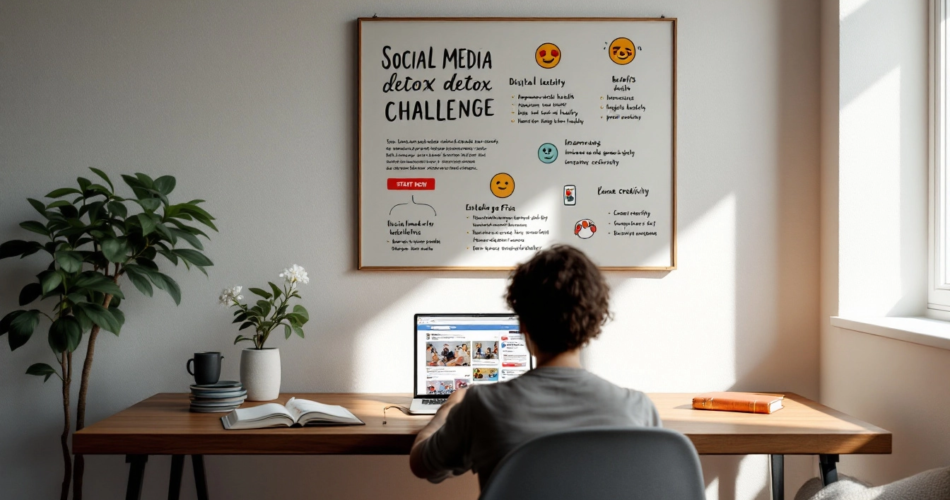Feeling overwhelmed by constant notifications and endless scrolling? You’re not alone. In today’s hyper-connected world, the relentless pull of social media can take a serious toll on your mental health, productivity, and overall well-being. Whether it’s the anxiety of keeping up with updates or the exhaustion of non-stop scrolling, digital overload is real—and it’s affecting more people than ever. Luckily, there’s a way to hit pause, reclaim your time, and restore balance: the Social Media Detox Challenge. In this comprehensive guide, we’ll answer your most pressing questions about this transformative challenge, offering actionable tips and insights to help you embark on your journey to digital wellness.
Table of Contents
- What Is a Social Media Detox Challenge?
- Signs You Need a Social Media Detox
- How to Start Your Social Media Detox Challenge
- Benefits of Completing a Social Media Detox
- Tips & Tricks to Beat Digital Overload
- Frequently Asked Questions
What Is a Social Media Detox Challenge?
Definition and Overview
A social media detox challenge is a temporary break from social media with the goal of reducing its negative impacts on your mental health, focus, and overall lifestyle. Unlike quitting entirely, the detox is about setting clear boundaries and taking time away to reset your habits and mindset. It’s not about abandoning social media forever—it’s about using it more mindfully in the long term.
Why It’s Essential in Today’s World
Research shows excessive social media use is linked to increased anxiety, poor sleep, and reduced productivity. Endless scrolling fosters feelings of inadequacy, stress, and disconnection from the real world. [Source: Study on Mental Health Impacts of Social Media] With social media apps designed to keep you hooked, stepping back with a detox challenge is an essential step toward better well-being.
Signs You Need a Social Media Detox
Recognizing the Symptoms of Digital Overload
Do you feel anxious when you’re away from your phone? Are you constantly checking notifications, even when it interrupts your day? These are symptoms of digital overload. Other signs include procrastination, comparing yourself to others on social media, or feeling emotionally drained after using these platforms. [Learn more about recognizing technology addiction.]
Assessing Your Usage & Habits
Start by using apps like “Screen Time” or “Digital Wellbeing” to monitor how much time you spend on social media daily. Red flags include checking your phone first thing in the morning or mindlessly scrolling for hours. Tracking habits is the first step in understanding the areas where a detox can help.
How to Start Your Social Media Detox Challenge
Establish Clear Goals
Clarify what you want to achieve with your detox. Whether it’s reducing screen time, improving mental health, or rekindling personal connections, set a few achievable goals. For example: limiting usage to 30 minutes a day or unplugging entirely for a weekend.
Create a Plan for Success
Take gradual steps to minimize usage. This might include deleting apps temporarily, setting app timers, or turning off push notifications. Additionally, fill the free time with hobbies, exercise, or activities that bring joy and relaxation.
Stay Accountable
Team up with a friend or join an online group to share progress and stay motivated. Journaling your experience is another excellent way to track improvements and reflect on what you’ve gained during the detox.
Benefits of Completing a Social Media Detox
Improved Mental Health
One of the most significant advantages of a detox is better emotional well-being. Many participants report reduced stress and anxiety, improved focus, and a sense of mental clarity. [Study: Mental Health Benefits of Reducing Tech Usage]
Reclaimed Time and Productivity
Consider how much time you’ll save by eliminating hours of scrolling. Use that extra time to explore new hobbies, develop skills, or engage in self-care routines like yoga or reading.
Stronger Real-Life Connections
Social media can often pull us away from meaningful, in-person interactions. A detox creates opportunities to strengthen connections with loved ones and be more present in the moment.
Tips & Tricks to Beat Digital Overload
Alternatives to Social Media During the Detox
Fill your detox period with enriching offline activities. Read books, listen to podcasts, pick up drawing, take a walk in nature, or practice mindfulness. [Explore hobbies to enhance mindfulness.]
Gradual Reintroduction Post-Detox
When you’re ready to get back, avoid diving straight into old habits. Instead, reintroduce social media in a more balanced and intentional way by setting daily limits or avoiding usage during certain times of the day.
Apps and Tools to Help
Consider using apps like “Freedom” or “Focus@Will” to block distracting websites and enhance productivity. [Check out tools to manage digital habits.]
Frequently Asked Questions
What is the ideal duration for a social media detox challenge?
This depends on your goals. Some opt for a weekend detox, while others choose a week or even a month. Start with a shorter duration and adjust based on results.
Can I still use social media for work during a detox?
If your job requires social media, set strict boundaries. Allocate specific hours for professional use and avoid recreational scrolling.
What if I fail to stick to the challenge?
It’s okay to slip up! Reflect on the reasons behind your setback and adjust your goals. Remember, progress is better than perfection.
How do I prevent a relapse post-detox?
Set long-term boundaries, such as no-phone zones or screen-free hours, to maintain healthy habits after the detox.
Are there health benefits to reducing screen time?
Yes! Reducing screen time can improve sleep quality, decrease anxiety, and boost focus, among other benefits.
Conclusion
Digital overload is a growing concern in today’s fast-paced, tech-driven world, but the Social Media Detox Challenge offers a simple yet effective solution for reclaiming control. By stepping back, you can enjoy better mental health, forge deeper personal connections, and find time for the things that truly matter. So why wait? Take the first step toward a healthier, more intentional digital lifestyle by starting your social media detox challenge today. Trust us—you’ll thank yourself later.


